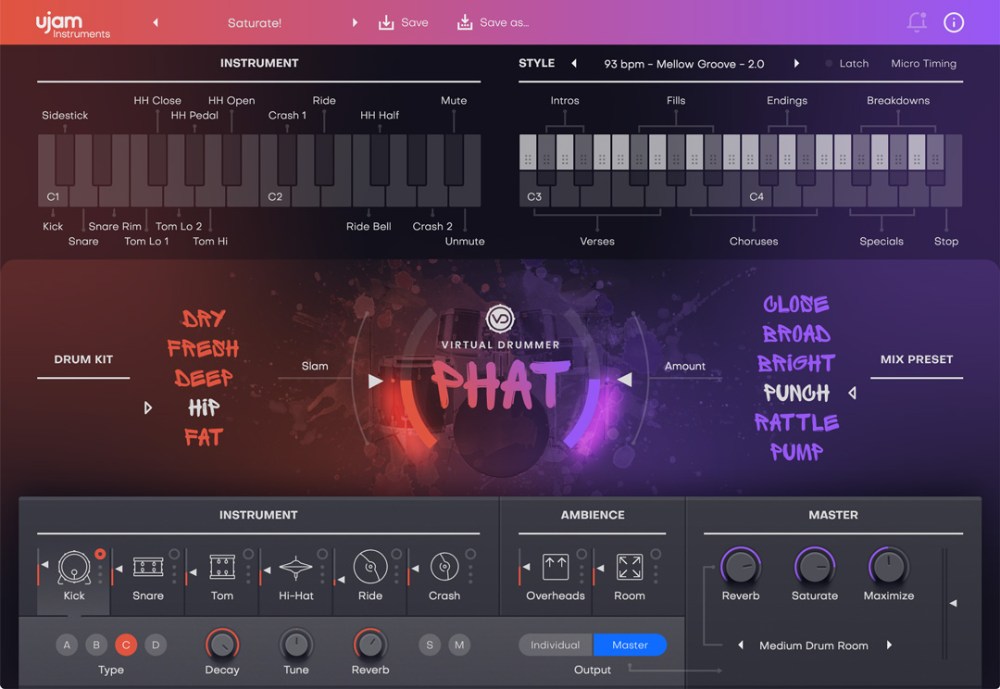

Clicking the frequency box above opens a pop up menu from which you may choose a different lock value. The metronome icon toggles tempo locking. Interestingly the frequency can be modulated by another LFO or even an envelope source. The stepper is available as a modulation source on modulate able controls.ĭrumSpillage 2.0 offers 4 LFOs per pad. You’ll be presented with a pop up menu to choose the step timing. Timing of each step can be adjusted by clicking the timing box (shown here as 1/8). The envelope can be set to loop (or not) and the number of steps can be adjusted to accommodate interesting rhythmic effects (e.g. The stepper is a 16 step editable envelope source with control over step tempo division. with the exception of the new Stepper envelope and improved tempo lock menu. The envelope editor is mostly the same as V1.0.

Scrolling through the models is non-destructive so if you cycle through several models you can return to the sound you originally had. The model selector menu changes the current model in use. This is useful for when the model has been changed and you find you want to return to a default state. Positive values cause velocity to excite the control whereas negative values push a control’s value down. If a velocity control is set to a value other than 0.0 (mid point) and the velocity switch is ‘off’ then a small ‘V’ indicates that the control is set. The velocity switch toggles their visibility but the controls are always active regardless. V2 features a new velocity system which operates in a similar fashion to the modulation controls. This approach is mirrored elsewhere in the plugin. The depth of the effect is controlled by the modulation slider labelled ‘M’. Pitch can also be modulated by any of the LFO or envelope sources and is accessed via the menu above the slider. Presence provides a little more boost and warmth allowing sounds to cut through the mix a little more. This is especially important for bass drums but also useful on snare for example. The pitch envelope contours the pitch according to the current state of the pitch envelope.

Pitch controls the basic fundamental for the pad. The pitch and presence controls (formally ‘Emphasis’) have been standardised for each model. In the model editing section you’ll find a standard tool bar containing essential controls such as load/save pads, mute group, output port and panning. When keyboard mode is activated a pad can be played across the entire MIDI keyboard range. Mute, solo and load/save pad buttons are also provided along with peak metering and oscilloscope views. The pad interface displays 16 pads simultaneously including volume and pan controls. Global kit volume can be adjusted by the scrollable box next to the main output meters. Kits can be cycled via the left/right arrows. The main editing mode is selected via the two icons at the top left. Pads are currently hard wired to MIDI keys C1 and upwards. 5 beta kits are provided and can be accessed via the kit load/save menu. Upon instantiation you’ll be presented with a basic default state. DrumSpillage features 12 original drum models designed for synthesizing a diverse variety of unique electronic percussion sounds.
DRUMSPILLAGE 2 KVR FOR MAC OS
The company is rightly proud of the Machinedrum.Welcome to this DrumSpillage quick start guide! DrumSpillage 2 is a 16 part multi model drum synthesizer plugin for Mac OS X. The Machinedrum was continually updated and occasionally upgraded by Elektron, eventually ending its lengthy lifespan in 2016 as the Machinedrum SPS-1UW+ MkII, which brought increases in power, pattern length, and onboard storage space.Įlektron still makes drum machines, though these days, they’re largely based on analogue and/or sampling. This meant that no two steps needed sound even remotely alike. Known as ‘parameter locking’, it allowed users to define the states of a vast number of synthesis and effects parameters for each step of a sequence. As well as the user-assigned machine, the Machinedrum’s 16 tracks offered EQ, sample-rate reduction, filtering, LFOs and effect sends.Īll of this would earn the Machinedrum favour, but there was one more very important feature that pushed it over the top. In 2005, the SPS-1UW brought two more machines that helped realtime sampling and playback of user waves. The aforementioned x0x-like TRX synth was joined by the FM-based EFM engine the physical modelling PI synth a 12-bit sample-playback synth in the form of E12 and the utilitarian GND, used to generate noise or sine waves, as well as allowing the inputs around the back to be routed and processed. In turn, each machine had its own unique set of tweakable parameters. Better still, they were just the tip of the iceberg, as the SPS-1 also offered another four synthesis methods, each one with a unique subset of ‘machines’ dedicated to specific types of drum sounds (bass, snare, etc).


 0 kommentar(er)
0 kommentar(er)
